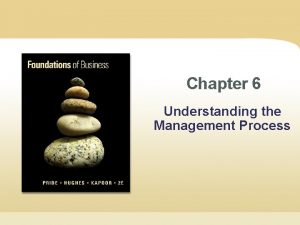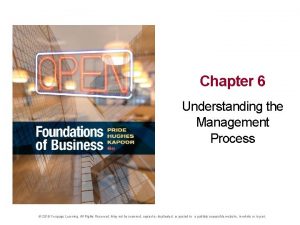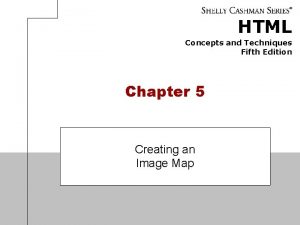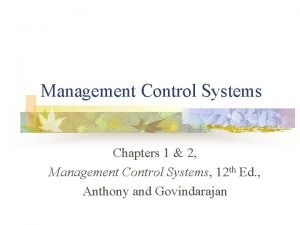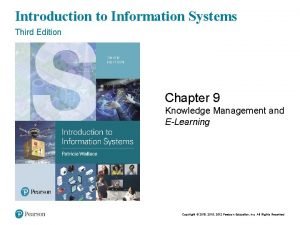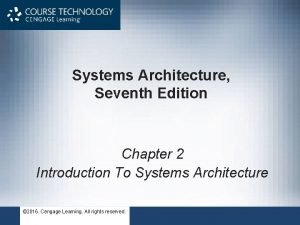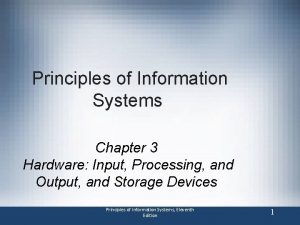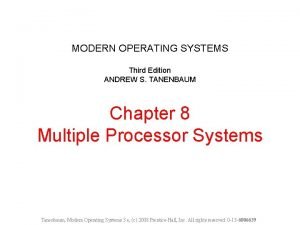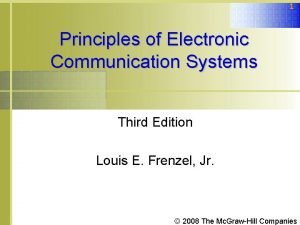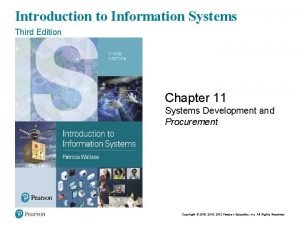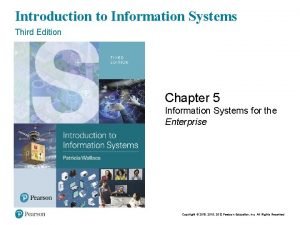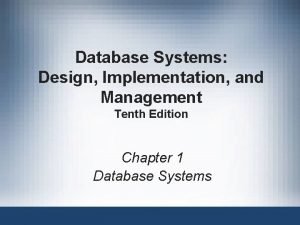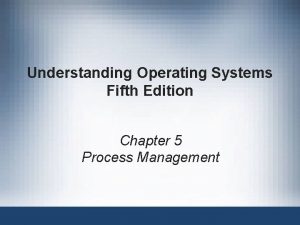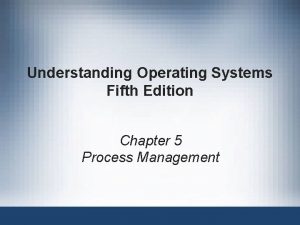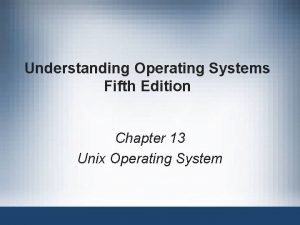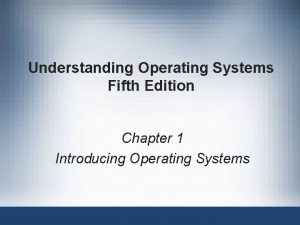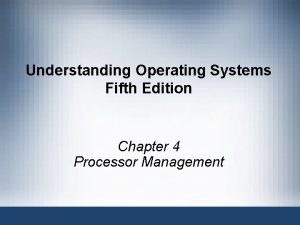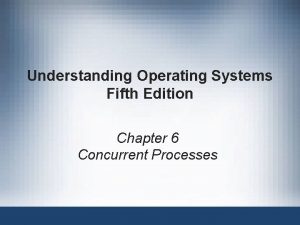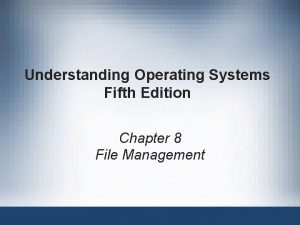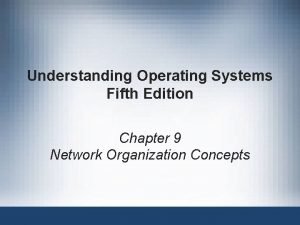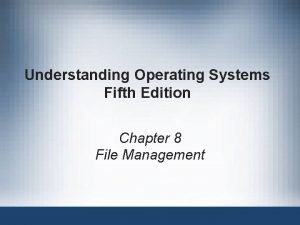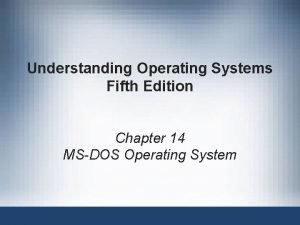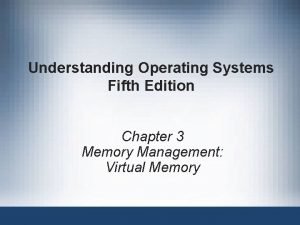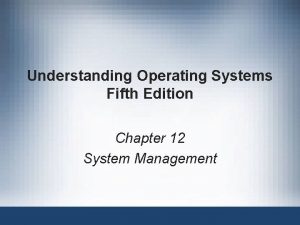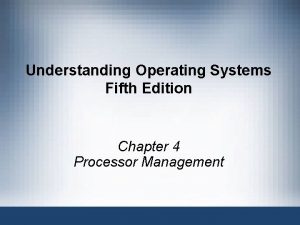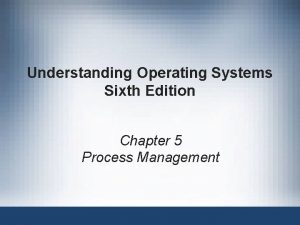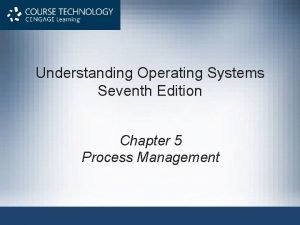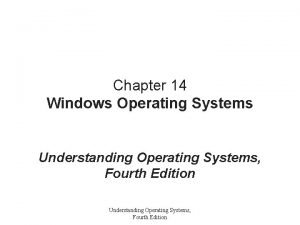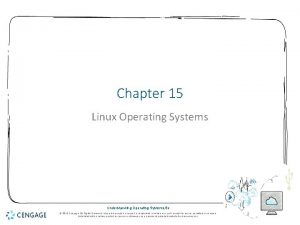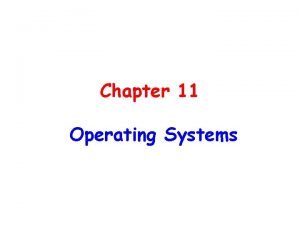Understanding Operating Systems Fifth Edition Chapter 5 Process























































- Slides: 55

Understanding Operating Systems Fifth Edition Chapter 5 Process Management

Learning Objectives • Several causes of system deadlock • The difference between preventing and avoiding deadlocks • How to detect and recover from deadlocks • The concept of process starvation and how to detect and recover from it • The concept of a race and how to prevent it • The difference between deadlock, starvation, and race Understanding Operating Systems, Fifth Edition 2

Deadlock • Resource sharing – Memory management and processor sharing • Many programs competing for limited resources • Lack of process synchronization consequences – Deadlock: “deadly embrace” • • Two or more jobs placed in HOLD state Jobs waiting for unavailable vital resource System comes to standstill Resolved via external intervention – Starvation • Infinite postponement of job Understanding Operating Systems, Fifth Edition 3

Deadlock (continued) • More serious than starvation • Affects entire system – Affects more than one job • Not just a few programs – All system resources become unavailable • Example: traffic jam (Figure 5. 1) • More prevalent in interactive systems • Real-time systems – Deadlocks quickly become critical situations • No simple and immediate solution Understanding Operating Systems, Fifth Edition 4

Deadlock (continued) Understanding Operating Systems, Fifth Edition 5

Seven Cases of Deadlock • Nonsharable/nonpreemptable resources – Allocated to jobs requiring same type of resources • Resource types locked by competing jobs – – – – File requests Databases Dedicated device allocation Multiple device allocation Spooling Disk sharing Network Understanding Operating Systems, Fifth Edition 6

Case 1: Deadlocks on File Requests • Jobs request and hold files for execution duration • Example (Figure 5. 2) – Two programs (P 1, P 2) and two files (F 1, F 2) – Deadlock sequence • P 1 has access to F 1 and also requires F 2 • P 2 has access to F 2 and also requires F 1 – Deadlock remains • Until one program withdrawn or • Until one program forcibly removed and file released – Other programs requiring F 1 or F 2 • Put on hold for duration of situation Understanding Operating Systems, Fifth Edition 7

Case 1: Deadlocks on File Requests (continued) Understanding Operating Systems, Fifth Edition 8

Case 2: Deadlocks in Databases • Two processes access and lock database records • Locking – Technique • One user locks out all other users • Users working with database – Three locking levels • Entire database for duration of request • Subsection of database • Individual record until request completed Understanding Operating Systems, Fifth Edition 9

Case 2: Deadlocks in Databases (continued) • Example: two processes (P 1 and P 2) – Each needs to update two records (R 1 and R 2) – Deadlock sequence • • P 1 accesses R 1 and locks it P 2 accesses R 2 and locks it P 1 requests R 2 but locked by P 2 requests R 1 but locked by P 1 • Race between processes – Results when locking not used – Causes incorrect final version of data – Depends on process execution order Understanding Operating Systems, Fifth Edition 10

Case 2: Deadlocks in Databases (continued) Understanding Operating Systems, Fifth Edition 11

Case 3: Deadlocks in Dedicated Device Allocation • Limited number of dedicated devices • Example – Two programs (P 1, P 2) • Need two tape drives each • Only two tape drives in system – Deadlock sequence • • P 1 requests tape drive 1 and gets it P 2 requests tape drive 2 and gets it P 1 requests tape drive 2 but blocked P 2 requests tape drive 1 but blocked Understanding Operating Systems, Fifth Edition 12

Case 4: Deadlocks in Multiple Device Allocation • Several processes request and hold dedicated devices • Example (Figure 5. 4) – Three programs (P 1, P 2, P 3) – Three dedicated devices (tape drive, printer, plotter) – Deadlock sequence • • • P 1 requests and gets tape drive P 2 requests and gets printer P 3 requests and gets the plotter P 1 requests printer but blocked P 2 requests plotter but blocked P 3 requests tape drive but blocked Understanding Operating Systems, Fifth Edition 13

Case 4: Deadlocks in Multiple Device Allocation (continued) Understanding Operating Systems, Fifth Edition 14

Case 5: Deadlocks in Spooling • Virtual device – Dedicated device made sharable – Example • Printer: high-speed disk device between printer and CPU • Spooling – Process • Disk accepts output from several users • Acts as temporary storage for output • Output resides in disk area until printer accepts job data Understanding Operating Systems, Fifth Edition 15

Case 5: Deadlocks in Spooling (continued) • Deadlock sequence – Printer needs all job output before printing begins • • Spooling system fills disk space area No one job has entire print output in spool area Results in partially completed output for all jobs Results in deadlock Understanding Operating Systems, Fifth Edition 16

Case 6: Deadlocks in a Network • No network protocols controlling network message flow • Example (Figure 5. 5) – Seven computers on network • Each on different nodes – Direction of arrows • Indicates message flow – Deadlock sequence • All available buffer space fills Understanding Operating Systems, Fifth Edition 17

Case 6: Deadlocks in a Network (continued) Understanding Operating Systems, Fifth Edition 18

Case 7: Deadlocks in Disk Sharing • Competing processes send conflicting commands – Scenario: disk access • Example (Figure 5. 6) – Two processes – Each process waiting for I/O request • One at cylinder 20 and one at cylinder 310 – Deadlock sequence • Neither I/O request satisfied • Device puts request on hold while attempting to fulfill other request for each request – Livelock results Understanding Operating Systems, Fifth Edition 19

Case 7: Deadlocks in Disk Sharing (continued) Understanding Operating Systems, Fifth Edition 20

Conditions for Deadlock • Four conditions simultaneously occurring prior to deadlock or livelock – – Mutual exclusion Resource holding No preemption Circular wait • All needed by operating system – Must recognize simultaneous occurrence of four conditions • Resolving deadlock – Removal of one condition Understanding Operating Systems, Fifth Edition 21

Conditions for Deadlock (continued) • Mutual exclusion – Allowing only one process access to dedicated resource • Resource holding – Holding resource and not releasing it – Waiting for other job to retreat • No preemption – Lack of temporary reallocation of resources Understanding Operating Systems, Fifth Edition 22

Conditions for Deadlock (continued) • Circular wait – Each process involved in impasse • Waiting voluntarily resource release by another so at least one can continue • All four required for deadlock occurrence • Deadlock remains until one condition removed Understanding Operating Systems, Fifth Edition 23

Modeling Deadlocks • Directed graphs – Circles represent processes – Squares represent resources – Solid arrow from resource to process • Process holding resource – Solid arrow from a process to resource • Process waiting for resource – Arrow direction indicates flow – Cycle in graph • Deadlock involving processes and resources Understanding Operating Systems, Fifth Edition 24

Modeling Deadlocks (continued) Understanding Operating Systems, Fifth Edition 25

Modeling Deadlocks (continued) • Three graph scenarios to help detect deadlocks – System has three processes (P 1, P 2, P 3) – System has three resources (R 1, R 2, R 3) • Scenario one: no deadlock – Resources released before next process request • Scenario two: deadlock – Processes waiting for resource held by another • Scenario three: no deadlock – Resources released before deadlock Understanding Operating Systems, Fifth Edition 26

Modeling Deadlocks (continued) • No deadlock – Resources released before next process request Understanding Operating Systems, Fifth Edition 27

Modeling Deadlocks (continued) Understanding Operating Systems, Fifth Edition 28

Modeling Deadlocks (continued) • Deadlock – Processes waiting for resource held by another Understanding Operating Systems, Fifth Edition 29

Modeling Deadlocks (continued) Understanding Operating Systems, Fifth Edition 30

Modeling Deadlocks (continued) • No deadlock – Resources released before deadlock Understanding Operating Systems, Fifth Edition 31

Modeling Deadlocks (continued) Understanding Operating Systems, Fifth Edition 32

Modeling Deadlocks (continued) • Another example – Resources of same type – Allocated individually or grouped in same process • Graph clusters devices into one entity – Allocated individually or grouped in different process • Graph clusters devices into one entity Understanding Operating Systems, Fifth Edition 33

Modeling Deadlocks (continued) Understanding Operating Systems, Fifth Edition 34

Strategies for Handling Deadlocks • Prevention – Prevent occurrence of one condition • Mutual exclusion, resource holding, no preemption, circular wait • Avoidance – Avoid deadlock if it becomes probable • Detection – Detect deadlock when it occurs – Recover gracefully • Recovery – Resume system normalcy quickly and gracefully Understanding Operating Systems, Fifth Edition 35

Strategies for Handling Deadlocks (continued) • Prevention eliminates one of four conditions – Complication: every resource cannot be eliminated from every condition – Mutual exclusion • Some resources must allocate exclusively • Bypassed if I/O device uses spooling – Resource holding • Bypassed if jobs request every necessary resource at creation time • Multiprogramming degree significantly decreased • Idle peripheral devices Understanding Operating Systems, Fifth Edition 36

Strategies for Handling Deadlocks (continued) • Prevention (continued) – No preemption • Bypassed if operating system allowed to deallocate resources from jobs • Okay if job state easily saved and restored • Not accepted to preempt dedicated I/O device or files during modification – Circular wait • • Bypassed if operating system prevents circle formation Use hierarchical ordering scheme Requires jobs to anticipate resource request order Difficult to satisfy all users Understanding Operating Systems, Fifth Edition 37

Strategies for Handling Deadlocks (continued) • Avoidance: use if condition cannot be removed – System knows ahead of time • Sequence of requests associated with each active process • Dijkstra’s Bankers Algorithm – Regulates resources allocation to avoid deadlock • No customer granted loan exceeding bank’s total capital • All customers given maximum credit limit • No customer allowed to borrow over limit • Sum of all loans will not exceed bank’s total capital Understanding Operating Systems, Fifth Edition 38

Strategies for Handling Deadlocks (continued) Understanding Operating Systems, Fifth Edition 39

Strategies for Handling Deadlocks (continued) Understanding Operating Systems, Fifth Edition 40

Strategies for Handling Deadlocks (continued) Understanding Operating Systems, Fifth Edition 41

Strategies for Handling Deadlocks (continued) Understanding Operating Systems, Fifth Edition 42

Strategies for Handling Deadlocks (continued) • Operating systems deadlock avoidance assurances – Never satisfy request if job state moves from safe to unsafe • Identify job with smallest number of remaining resources • Number of available resources => number needed for selected job to complete • Block request jeopardizing safe state Understanding Operating Systems, Fifth Edition 43

Strategies for Handling Deadlocks (continued) • Problems with the Banker’s Algorithm – Jobs must state maximum number needed resources – Requires constant number of total resources for each class – Number of jobs must remain fixed – Possible high overhead cost incurred – Resources not well utilized • Algorithm assumes worst case – Scheduling suffers • Result of poor utilization • Jobs kept waiting for resource allocation Understanding Operating Systems, Fifth Edition 44

Strategies for Handling Deadlocks (continued) • Detection: build directed resource graphs – Look for cycles • Algorithm detecting circularity – Executed whenever appropriate • Detection algorithm – Remove process using current resource and not waiting for one – Remove process waiting for one resource class • Not fully allocated – Go back to step 1 • Repeat steps 1 and 2 until all connecting lines removed Understanding Operating Systems, Fifth Edition 45

Strategies for Handling Deadlocks (continued) Understanding Operating Systems, Fifth Edition 46

Strategies for Handling Deadlocks (continued) Understanding Operating Systems, Fifth Edition 47

Strategies for Handling Deadlocks (continued) • Recovery – Deadlock untangled once detected – System returns to normal quickly • All recovery methods have at least one victim • Recovery methods – Terminate every job active in system • Restart jobs from beginning – Terminate only jobs involved in deadlock • Ask users to resubmit jobs – Identify jobs involved in deadlock • Terminate jobs one at a time Understanding Operating Systems, Fifth Edition 48

Strategies for Handling Deadlocks (continued) • Recovery methods (continued) – Interrupt jobs with record (snapshot) of progress – Select nondeadlocked job • Preempt its resources • Allocate resources to deadlocked process – Stop new jobs from entering system • Allow nondeadlocked jobs to complete • Releases resources when complete • No victim Understanding Operating Systems, Fifth Edition 49

Strategies for Handling Deadlocks (continued) • Factors to consider – Select victim with least-negative effect on the system – Most common • Job priority under consideration: high-priority jobs usually untouched • CPU time used by job: jobs close to completion usually left alone • Number of other jobs affected if job selected as victim • Jobs modifying data: usually not selected for termination (a database issue) Understanding Operating Systems, Fifth Edition 50

Starvation • Job execution prevented – Waiting for resources that never become available – Results from conservative resource allocation • Example – “The dining philosophers” by Dijkstra • Starvation avoidance – Implement algorithm tracking how long each job waiting for resources (aging) – Block new jobs until starving jobs satisfied Understanding Operating Systems, Fifth Edition 51

Starvation (continued) Understanding Operating Systems, Fifth Edition 52

Starvation (continued) Understanding Operating Systems, Fifth Edition 53

Summary • Operating system – Dynamically allocates resources – Avoids deadlock and starvation • Four methods for dealing with deadlocks – Prevention, avoidance, detection, recovery • Prevention – Remove simultaneous occurrence of one or more conditions – System will become deadlock-free – Prevention algorithms • Complex algorithms and high execution overhead Understanding Operating Systems, Fifth Edition 54

Summary (continued) • Avoid deadlocks – Clearly identify safe and unsafe states – Keep reserve resources to guarantee job completion – Disadvantage • System not fully utilized • No prevention support – System must detect and recover from deadlocks • Detection relies on selection of victim Understanding Operating Systems, Fifth Edition 55
 Understanding operating systems
Understanding operating systems Modern operating systems 3rd edition
Modern operating systems 3rd edition Modern operating systems tanenbaum 5th edition
Modern operating systems tanenbaum 5th edition Principles of marketing fifth european edition
Principles of marketing fifth european edition Facial feedback hypothesis
Facial feedback hypothesis Fundamentals of corporate finance fifth edition
Fundamentals of corporate finance fifth edition Democritus atomic model diagram
Democritus atomic model diagram Segregat
Segregat Molecular biology of the cell fifth edition
Molecular biology of the cell fifth edition Human anatomy fifth edition
Human anatomy fifth edition Human anatomy fifth edition
Human anatomy fifth edition Adler and rodman 2006
Adler and rodman 2006 Business essentials 12th edition
Business essentials 12th edition Understanding nutrition 13th edition rental
Understanding nutrition 13th edition rental Understanding movies 14th edition
Understanding movies 14th edition Understanding human differences 5th edition
Understanding human differences 5th edition Karst erosion
Karst erosion Understanding earth 7th edition
Understanding earth 7th edition Understanding earth 5th edition
Understanding earth 5th edition Understanding human communication 14th edition
Understanding human communication 14th edition Electron sharing
Electron sharing Understanding intercultural communication 2nd edition
Understanding intercultural communication 2nd edition Chapter 6 understanding the management process
Chapter 6 understanding the management process The process of evaluating and regulating ongoing activities
The process of evaluating and regulating ongoing activities Using mis 10th edition
Using mis 10th edition Mis
Mis Operating system concepts, 10th edition
Operating system concepts, 10th edition Operating system concepts 6th edition
Operating system concepts 6th edition The harder you push the harder the system pushes back
The harder you push the harder the system pushes back Fifth chapter menu
Fifth chapter menu Understanding experience in interactive systems
Understanding experience in interactive systems Amchip
Amchip Principles of electronic communication systems 3rd edition
Principles of electronic communication systems 3rd edition Modern systems analysis and design
Modern systems analysis and design Introduction to radar systems skolnik
Introduction to radar systems skolnik Introduction to information systems 6th edition
Introduction to information systems 6th edition Fundamentals of information systems 9th edition
Fundamentals of information systems 9th edition Fundamentals of information systems 9th edition
Fundamentals of information systems 9th edition Principles of information systems
Principles of information systems Vertical
Vertical What is goal congruence in management control system
What is goal congruence in management control system Introduction to information systems 3rd edition
Introduction to information systems 3rd edition Introduction to management information systems 5th edition
Introduction to management information systems 5th edition Systems architecture 7th edition
Systems architecture 7th edition Principles of information system
Principles of information system Principles of information systems 11th edition
Principles of information systems 11th edition Modern systems analysis and design 7th edition
Modern systems analysis and design 7th edition Modern operating systems tanenbaum
Modern operating systems tanenbaum Fundamentals of information systems
Fundamentals of information systems Voyage estimating decision support system
Voyage estimating decision support system Principles of electronic communication systems 3rd edition
Principles of electronic communication systems 3rd edition Introduction to information systems 3rd edition
Introduction to information systems 3rd edition Fundamentals of information systems 9th edition
Fundamentals of information systems 9th edition Introduction to information systems 3rd edition
Introduction to information systems 3rd edition Database systems 10th edition
Database systems 10th edition Expert systems: principles and programming, fourth edition
Expert systems: principles and programming, fourth edition






















